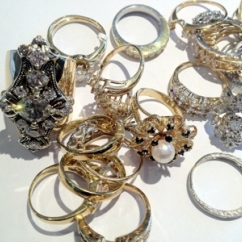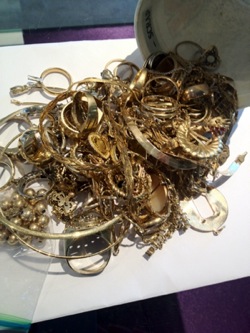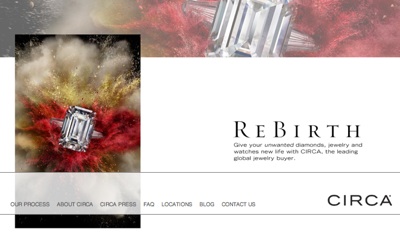Articles and News
TAKING IT TO THE STREET: THE NEW PLACE TO PROFIT | July 18, 2012 (0 comments)

Merrick, NY—With both diamond and gold prices rocketing, the street is now a major source of supply for both. In fact, diamond industry pundit Martin Rapaport believes more diamonds are coming into the market from Americans who want to sell them than are coming out of South Africa.
“Every day someone comes in with a solitaire,” says Laura Stanley, president of Stanley Jewelers in North Little Rock, AR. There’s much more margin in diamonds bought off the street than those bought from suppliers and a jeweler can actually make some money instead of being squished, as she calls it, between suppliers’ prices and consumers’ price-shopping. Sometimes she’s even able to buy stones cheap enough to sell them to the trade rather than putting them in inventory.
“They sell, but they don’t sell as fast as you think they do. We can’t afford to be a diamond museum!” she says. Now, she regularly puts together parcels of stones she bought off the street—usually lots of one-caraters—and sells them to a few diamond dealers.
At Wilson & Son Jewelers in Scarsdale and Mt. Kisco, NY, buying jewelry from customers has always been part of business. But like many other luxury jewelers, it’s gotten to be a lot bigger part of the business in recent years, owing both to the recession and, more recently, the rocketing price of gold.
Not surprisingly, old gold is king of liquidation. “People sell all kinds of things, but especially anything in basic gold,” Wilson says. “Yellow,” adds Stanley. “I don’t know why, but we rarely get any white gold off the street. It’s almost all yellow.”

This bucket of scrap from Stanley Jewelers is almost entirely yellow gold. Top of page, pieces that will go into inventory.
Often it’s heavy ‘70s or ’80s style jewelry that’s just been sitting in the jewelry box, says Wilson. And sometimes the customer is thrilled to shed both the piece and the karma that went with it—like gifts from an ex.
“The saddest situations are the people who come in because they need to sell jewelry to make the rent,” he says. That naturally takes special gentleness, but he says a customer that remembers being dealt with kindly at a time when others may not have been so sensitive can become a champion of the store later.
Stanley says distress actually drives about 70% of her street buying. “I hate it when they tell the story, because you know it’s not going to be good.” But you have to listen and just hope the tale isn’t so heartrending as to affect your business decisions—which she acknowledges happens more often than she’d like.
“When you factor the story in, you just want to give more than [the piece] is worth.” She tells of one customer, desperate for cash, who came in with a 10k gold ring that had been her great-grandfather’s. The ring was worth about $40, says Stanley, but she gave the customer $50.
“$10 doesn’t seem like a lot, but it adds up,” she admits.
Not every street sale is a hardship. Many are fashion-driven exchanges of pieces that customers no longer love or pieces they’ve inherited but will never wear.
At Underwood Jewelers in Jacksonville, FL, trade-in is a very important part of business. Most of what comes in for trade is jewelry sold by Underwood’s in the first place, says president Clayton Bromberg. The firm encourages trade-ins with its “Grow A Diamond” program. Underwood’s, like many prestige jewelers, will give 25% more on a trade-in than a sale. Bromberg says each of the firm’s four stores—his own, plus three Bromberg & Co. locations in Birmingham, AL—differ slightly in what customers buy and sell, but across the board it’s very common for a customer to trade Grandma’s jewelry for something they will wear.
“If it’s a difference between a $1,000 check and $1,250 in store credit, they usually come back with more to sell!” he laughs.
Sometimes customers are sentimental and don’t want to let go of Grandma entirely. Remodeling and restoration is another big part of the resale market—about 1/3 of the pieces that come into Stanley jewelers, for example, are reworked. Bob Moeller of R.F. Moeller in Minneapolis and St. Paul, MN, says his firm also does a lot of remodeling, including re-cutting or re-polishing stones.
“[Remodeling] is our most fun thing to do! We have a fabulous bench jeweler, and it’s what sets us apart. It’s fun to make a silk purse out of a sow’s ear,” says Ricky Bromberg, president of Bromberg’s in Birmingham.
The ability to carry on a tradition with a new modern setting has its appeal, and so does the recycling aspect of buying jewelry. “People really like to hear how much [precious jewelry] is recycled. It can be a big selling point with many customers,” says Wilson.
Turning buying into an event. While most luxury jewelers have a fairly steady stream of jewelry coming in off the street, sometimes customers need a little nudge. That’s where an event can help. Both Bromberg’s/Underwood’s and Wilson & Son have worked with the buying agency Circa for several buying events. Mike Wilson says the advertising Circa brings into the area is a tremendous traffic builder.

CIrca's homepage emphasizes giving unwanted jewelry new life by selling it. Its consumer advertising campaign continues in the same vein, touting the environmental conservation aspect of selling old gems by reducing the need to mine new ones.
“We get lots of curious people and a lot of new faces,” he says of the Circa events, typically held for two days twice a year. “The advertising creates a lot of excitement for the event, but the event creates awareness that we do buying every day—it’s not just about one day or two days [of Circa events].”
“It’s been good for us,” says Ricky Bromberg. “We’re not really in the estate business. We always do trade in diamonds, but we don’t buy unusual pieces over the counter, so it seemed like something we probably needed [to try].” Bromberg didn’t know what to expect before the first Circa event, but he was amazed at the demand and how many people came in.
“It went gangbusters. We had more people than we could handle,” he said. They’ve now held three events—fall 2010, fall 2011, and spring 2012—and are planning a fourth for this fall. They also now know they need more Circa agents at the events.
“We added it as a service,” says Clayton Bromberg. “It’s helped expand our customer base without [us] having to go into the estate business—which we don’t want to be in.” Both he and Ricky say it’s been mutually beneficial because the Underwood name adds credibility to Circa whom customers may not have heard of, and Circa allows them to offer buying beyond scrap.
Laura Stanley, meanwhile, loves estate and consignment, but she rarely has special events around the category. At Stanley Jewelers, it’s just business as usual.
“About 40% of our showcase space is [second-hand],” she says. Most people would rather just leave a distinctive piece with Stanley to sell than scrap it, and if she can’t sell it, she finds someone who can. “We had this platinum line bracelet from the 1930s. A lady had inherited it along with a five-carat pear that Dad [Loyd Stanley, who is still active in the business] bought. It was a really great bracelet so we didn’t want to scrap it but it was nothing we could sell. I sent it to McTeigue in New York. They kept it a few weeks and found a buyer, so the customer was happy.”
“If it’s a nice piece with a lot of value but not our market, we’ll sell it off to another [jewelry] business,” concurs Bob Moeller.
90% of the reason why customers buy second-hand is price, Stanley says. About 10% are looking for something that’s very specifically old, but otherwise, it’s all about a bargain. “Even the richest people in town want a bargain,” she told The Centurion. “Their bargain might be $50,000 instead of $70,000, while someone else’s bargain is $100, but everybody wants a bargain.” She’s actually gearing up to try a more elegant version of the “deal of the week” newsletters she gets from New York diamond dealers. “We’ll advertise an estate diamond in a new setting, and it’s a great value.”
Low gold at $1600? With the proliferation of “cash for gold” ads, one has to wonder how much jewelry is left to buy on the street. How deep do American jewelry boxes go?
Stanley says buying really peaked last year—coincidentally with the biggest leaps in gold—and fallen off slightly this year, but still remains well above what the firm used to do five years ago. The new thing she’s seeing? Coins. Not collectible coins, just regular silver coins from pre-1964.
“Dad likes to keep them,” she says. She’s not sure if it’s even legal to melt them down, but says it’s fun to see the history in them.
Bob Moeller says the amount of buying at his stores has decreased lately, mainly because people have a lot more options to sell jewelry and especially gold. “We’re still aggressive buyers, but mostly diamonds. Not so much gold,” he says.
Wilson concurs. He’s been monitoring his street business regularly and, while it hasn’t dropped, he has noticed it’s gotten a little slower since gold dipped from its all-time high. “At $1,700 or more, people were going crazy selling. They’d run through a brick wall to sell. But at $1,600, people think it’s [gold is] low. It’s not low. It’s still high! We educate our customers that it’s still ok to sell now,” he says. He believes gold will go back up, and thinks $2,000 isn’t unlikely—but he doesn’t think it’ll hit the $3,000 mark that some in the investment arena predict.
How to get started. Stanley’s advice for jewelers who want to get into buying, consignment, or estate jewelry, is to first learn the laws. There are lots of things you can and can’t do, she says. Case in point—the state of Arkansas turned regulation back to the individual cities, and in North Little Rock there’s a waiting period of three weeks between the time a jeweler buys a piece and when he can sell or melt it. This is mainly to prevent stolen goods from being liquidated, she says.
Second, says Stanley, realize you’re going to be dealing with the public on a different level than if you were just selling jewelry. You now have to manage their expectations of what they’re going to get for a piece, yet still justify why new jewelry costs so much more. You have to be honest but still compassionate, which is hard, and be prepared for people to get upset when they realize they’re probably not going to get what they think they should.
“A lot of people walk out because our offer wasn’t enough. And they usually come back two or three weeks later. They’ve shopped around and they realize our offer wasn’t bad!”
Finally, if you’re going to specialize in estate jewelry, you have to know your stuff. It doesn’t matter so much if you’re just going to buy gold, but if you’re going to position yourself as an expert in estate jewelry, you’d better know what you’re talking about.







